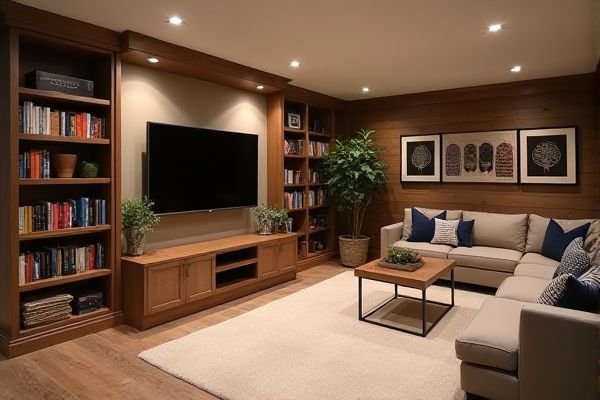
Built-in bookcases optimize basement space by providing sturdy, custom storage tailored to your needs, while open shelving offers flexibility and easy access to frequently used items. Discover the advantages and design tips for both options to enhance your basement's functionality and aesthetics by reading the rest of this article.
Table of Comparison
| Feature | Built-in Bookcase | Open Shelving Basement |
|---|---|---|
| Design | Custom-fitted, integrated with walls | Freestanding or wall-mounted, exposed structure |
| Storage Capacity | High, maximizes vertical space | Moderate, flexible shelf placement |
| Durability | Sturdy, often made of solid wood or MDF | Variable, depends on material and installation |
| Installation | Permanent, professional installation required | Easy to install, DIY-friendly |
| Cost | Higher initial cost due to customization | Lower cost, less material and labor |
| Maintenance | Low maintenance, integrated design | Requires regular dusting and cleaning |
| Aesthetic Appeal | Seamless, polished look | Casual, industrial or rustic vibe |
| Flexibility | Fixed layout, limited repositioning | Highly flexible, adjustable shelves |
| Best Use | Permanent storage, organized display | Temporary or versatile storage needs |
Introduction: Choosing Storage for Your Basement
Selecting the ideal storage solution for your basement involves weighing the benefits of built-in bookcases against open shelving options. Built-in bookcases offer customized, space-saving designs that enhance durability and provide a cohesive aesthetic tailored to basement dimensions. Open shelving, however, maximizes accessibility and airflow, making it suitable for frequently used items and creating an airy, organized appearance.
Built-In Bookcase: Definition and Features
A built-in bookcase is a custom-designed shelving unit integrated directly into the walls of a basement, offering a seamless and permanent storage solution. These bookcases often feature adjustable shelves, decorative molding, and can be tailored to match the room's architectural style, maximizing space efficiency. Unlike open shelving, built-ins provide enhanced durability and a polished look that adds both functionality and value to basement interiors.
Open Shelving: Definition and Features
Open shelving in a basement consists of exposed shelves without doors or panels, offering easy access and a minimalist aesthetic. These shelves are typically made from wood, metal, or laminate materials, allowing for customization in size and arrangement to fit your storage needs. Open shelving enhances visibility of items, making organization simple while contributing to an airy, open feel in your basement space.
Space Efficiency Comparison
Built-in bookcases maximize space efficiency in your basement by utilizing vertical walls and corners, providing ample storage without occupying floor area. Open shelving offers flexibility and ease of access but may consume more usable space, especially in smaller basements. Choosing built-in bookcases enhances organization and keeps the basement uncluttered, optimizing every inch of available space.
Aesthetic Appeal and Design Flexibility
Built-in bookcases in basements offer a polished, cohesive aesthetic that seamlessly integrates with your space, enhancing both style and value. Open shelving provides greater design flexibility, allowing you to easily rearrange decor and accommodate changing storage needs while maintaining an airy feel. Choosing between the two depends on whether you prioritize a custom, permanent look or adaptable, minimalist functionality.
Durability and Maintenance Needs
Built-in bookcases in basements offer superior durability due to their fixed structure and use of sturdy materials like hardwood or plywood, ensuring long-term stability and resistance to moisture compared to open shelving. Maintenance needs for built-in units are minimal, often requiring only occasional dusting and protection against humidity, whereas open shelving may need more frequent cleaning and monitoring as it is more exposed to dust and potential damage. Your choice should consider the basement's environment and how much upkeep you're prepared to manage for preserving the shelving's appearance and function.
Cost Considerations: Built-In vs Open Shelving
Built-in bookcases typically involve higher upfront costs due to materials, custom design, and professional installation, whereas open shelving offers a more budget-friendly option with easier DIY possibilities. Maintenance expenses for built-ins may rise over time because of repairs or refinishing, while open shelves allow simple replacements or adjustments. Your choice should balance initial investment with long-term usability and aesthetic preferences to maximize value in your basement.
Customization Options for Each Solution
Built-in bookcases offer extensive customization options, including tailored dimensions, integrated lighting, and choice of materials to seamlessly match your basement's architecture. Open shelving provides flexible configurations with adjustable heights, modular components, and easy relocation or expansion to suit changing storage needs. Your selection depends on whether you prioritize permanence and style or adaptability and simplicity in your basement organization.
Best Uses: Which Option Fits Your Basement Needs
Built-in bookcases maximize storage efficiency and provide a polished, permanent solution ideal for basements needing organized, space-saving storage with a uniform look. Open shelving offers flexibility and easy access, perfect for basements used as casual living spaces or workshops where quick retrieval and display of items matter most. Consider your basement's purpose, aesthetic goals, and storage requirements to determine which option best fits your needs and enhances your overall space functionality.
Final Verdict: Making the Right Choice
Choosing between a built-in bookcase and open shelving for a basement hinges on storage needs and aesthetic preferences. Built-in bookcases provide sturdy, customized solutions ideal for maximizing space and protecting items from dust and moisture. Open shelving offers a flexible, airy display option but may require more maintenance in basement environments prone to humidity.
 homyna.com
homyna.com